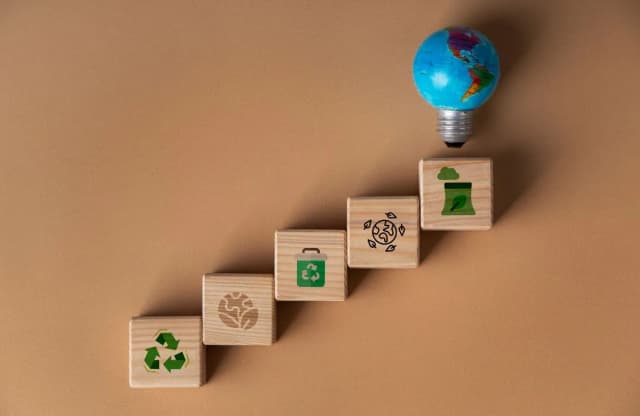The Three Pillars of Sustainable Development

“Sustainability is not a goal to be reached but a way of thinking, a way of being, a way of living.”
As the world faces unprecedented challenges, from climate change and social inequality to economic instability, the concept of sustainable development has become more urgent than ever. At its core, sustainable development rests on three interconnected pillars: economic growth, social inclusion, and environmental protection. These pillars aren’t just abstract ideals; they shape how nations, businesses, and communities thrive in harmony with the planet.
In this article, we will talk in detail about these three pillars of sustainable development, how they work together, and how they will help you create expandable solutions that work in any organization.
What is Sustainable Development?
"Sustainable development is development that meets the needs of the present without compromising the ability of future generations to meet their own needs. It’s a way of building our future by making smart choices now, so we have clean air, enough food, good jobs, and a healthy planet for generations to come. The concept of sustainable development has grown a lot throughout history. It shows how our relationship with the natural world has changed, and we've become more aware of ecological limits. This isn't just another environmental movement. It presents a complete vision for human progress that balances multiple priorities.
What are the 3 Pillars of Sustainable Development?
Like a tripod, three points offer perfect equilibrium. Remove one, and the structure collapses, just like development efforts that ignore any one pillar.
The three pillars of sustainable development, economic growth, social inclusion, and environmental protection are not just principles, but the blueprint for a thriving, equitable, and resilient world.

Environmental Pillar: Focus and examples
Living within the means of our natural resources is a key definition of environmental sustainability. This pillar aims to preserve and protect the health of nature through responsible resource management, pollution reduction, and maintaining ecological balance.
The environmental pillar includes several key focus areas:
- Conservation of biodiversity - Protecting diverse organisms, plants, animals, and microorganisms in the environment
- Preservation of natural resources - Ensuring resources are consumed at sustainable rates
- Reduction of environmental impact - Managing pollution, waste, and emission controls
- Climate action - Implementing strategies to reduce greenhouse gas emissions and promote adaptation
Businesses apply environmental sustainability through various approaches. Modern organizations reduce water consumption, packaging waste, freight distances, and carbon footprints to meet their sustainability and Environmental, Social, and Governance (ESG) goals. Reducing packaging materials and freight distances cuts material and fuel costs while benefiting the environment.
Companies in clean technologies, green buildings, waste management, renewable energies, and sustainable agriculture develop research capabilities and environmental strategies to improve sustainability. These efforts help reduce the footprint and resource consumption of industrial activities.
Social Pillar: Focus and examples
People's well-being and communities stand at the heart of social sustainability. It promotes equity, human rights, access to education and healthcare, and decent work opportunities. Society's ability to achieve good social well-being defines this pillar's long-term success.
The social pillar includes several principles:
- Acknowledging social issues - Integrating values like racial and gender equality in operations
- Promoting solidarity - Reducing social inequalities through collaboration with local and international associations
- Fostering safe workplaces - Ensuring fair treatment and compensation for all employees and stakeholders
- Community participation - Encouraging involvement in decisions affecting community life
Businesses implement social sustainability through corporate social responsibility initiatives focused on health, education, and community development. Fair trade practices ensure workers receive equitable compensation and secure working conditions. Inclusive hiring practices encourage recruitment from diverse backgrounds.
Social sustainability creates inclusive societies, reduces inequality, and ensures long-term well-being while preserving social cohesion and justice. Community engagement programs, educational opportunities, and vocational training help individuals and communities improve their socioeconomic status.
Economic Pillar: Focus and examples
Businesses and countries must use resources efficiently to operate sustainably and produce consistent profits. This pillar aims to improve the standard of living for employees and stakeholders associated with businesses.
The economic pillar focuses on several key areas:
- Sustainable economic growth - Increasing economic production without deterioration
- Resource efficiency - Utilizing resources effectively to reduce waste and minimize costs
- Innovation and technology - Investing in practices and technologies that reduce environmental impacts while increasing productivity
- Financial stability - Implementing robust financial management and transparent reporting
Economic sustainability involves equitable resource allocation, focusing on both profitability and long-term benefits. Government policies, applied technologies, and sustainable business models help achieve a stable global economy that provides a quality of life without environmental damage.
Organizations invest in sustainable infrastructure and renewable energy projects. They adopt circular economy models that prioritize resource efficiency and waste reduction. Sustainable supply chain management emphasizes ethical sourcing and fair labor practices.
Resource efficiency strategies help address resource scarcity. Organizations monitor consumption indicators, provide sustainable consumer choices, and reduce energy and material use.
Interconnection between the three pillars
These pillars work together as interconnected aspects rather than isolated components. True sustainability emerges when environmental, social, and economic pillars balance in equal harmony.
Balancing two pillars creates specific conditions:
- Social + Economic Sustainability = Equitable
- Social + Environmental Sustainability = Bearable
- Economic + Environmental Sustainability = Viable
True sustainability requires all three pillars working together.
Good environmental practices maintain economic stability. Low-carbon economy transitions create economic opportunities, accelerate innovation, and increase business competitiveness.
Social aspects connect to both environmental and economic dimensions. Reduced inequalities and social cohesion support a sustainable economy.
Climate change shows the impossibility of social and economic sustainability without environmental care. Businesses develop broader purposes and create deliverables that benefit society.
Public sustainability goals bring valuable benefits, including goodwill and enhanced corporate social responsibility reputation.
The three-pillar framework provides a balanced approach to sustainable development challenges.
What is the 4th pillar of sustainable development?
Culture stands as the fourth pillar of sustainable development alongside economic, environmental, and social dimensions.
The Executive Bureau of United Cities and Local Governments gave this concept official recognition in November 2010 through their Policy Statement "Culture is the Fourth Pillar of Sustainable Development". This changed how we look at sustainability frameworks.
The fourth pillar of culture brings together values, diversity, heritage, knowledge, and creativity that build human societies. It has both physical elements, like historic buildings and artifacts, and non-physical aspects, such as traditions, languages, and artistic expressions.
The original three dimensions couldn't capture the complexity of modern society. Cultural aspects help define development and shape people's actions in the world.
Role of culture in sustainability
Culture changes sustainability in several ways. It shapes our values and beliefs, which in turn affect how we treat the environment and society
Culture offers practical benefits for sustainability:
- Economic vitality: Cultural tourism accounts for 40% of world tourism revenues, which creates jobs and helps local economies
- Social cohesion: Cultural activities bring people together and build stronger communities
- Environmental wisdom: Traditional crafts often include local knowledge about managing ecosystems and using resources wisely
- Education enhancement: Culture in education builds confidence, opens dialogue, and helps students learn more skills
Many policy areas now include culture in development. From creating jobs in the cultural sector to improving education quality and supporting environmental sustainability, culture offers relevant solutions to complex problems.
How organizations are using sustainable development frameworks?
Businesses must do more than make surface changes to use sustainable development principles. They need to weave these principles into their core policies and processes. This doesn't mean creating new management methods, but building a new cultural direction with better systems and practices.
Organizations usually change their management systems in two main ways. They become more accountable to stakeholders beyond shareholders. They also improve how they report their sustainability performance.
The transition of sustainability into business core strategies makes competent workers an essential requirement. The IIM Mumbai Sustainability Management Course is designed to help professionals lead this change
Because , Good sustainability management needs both decision-making and governance changes. Business planning, information systems, and control systems must include sustainability.
Company culture makes a big difference in success. Many companies find new energy when they start sustainability policies.
Conclusion
Sustainable development means more than just theory, it's a practical roadmap that addresses our biggest global challenges. A closer look at sustainability pillars reveals several key insights worth highlighting.
The classic three-pillar approach has shaped sustainable development efforts for decades through economic, environmental, and social dimensions. Each pillar works differently yet together.
These pillars can't work alone, That’s why Culture has emerged as a vital fourth pillar, adding context to eco-friendly efforts. This dimension shows how human values, traditions, and creative expressions shape the way communities understand and use eco-friendly practices.
Organizations that adopt comprehensive sustainability strategies gain many advantages beyond just following regulations because The future of sustainable development needs unprecedented teamwork across sectors, disciplines, and nations.
Whether you work in sustainability management now or want to lead in this field later, understanding these connected pillars gives you the knowledge to create working solutions. The challenges might look big, but the frameworks we've explored show clear paths forward.
The trip toward sustainability needs balance, finding that sweet spot where economic success, environmental health, social fairness, and cultural energy support each other. This balance isn't easy to achieve, but it's our best hope to create a world where current and future generations can thrive.
Frequently Asked Questions
Q1. What are the three pillars?
The three pillars of sustainable development are economic growth, social inclusion, and environmental protection. Together, they ensure balanced progress that meets present needs without compromising future generations.
Q2. Why are these three pillars important?
These three pillars are essential for achieving long-term sustainability by promoting balanced development, driving economic progress, ensuring social equity, and protecting the environment for current and future generations.
Q3. How are the three pillars of sustainable development interconnected?
The three pillars - environmental, social, and economic - are deeply interconnected and must work together for true sustainability. Environmental practices support economic stability, social equity fosters a resilient economy, and a healthy environment is crucial for social well-being. Balancing all three creates conditions that are equitable, bearable, and viable.

TalentSprint
TalentSprint is a leading deep-tech education company. It partners with esteemed academic institutions and global corporations to offer advanced learning programs in deep-tech, management, and emerging technologies. Known for its high-impact programs co-created with think tanks and experts, TalentSprint blends academic expertise with practical industry experience.



